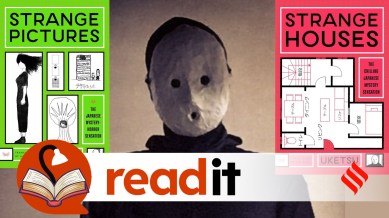Strange Houses: Masked author Uketsu turns floor plans into murder plots
Uketsu –Japan’s most mysterious bestselling author and creator of Strange Pictures and Strange Houses – is redefining horror and mystery through floor plans, sketches, and chilling twists.

A house with an airy, pleasant floor plan. On closer glance, a tiny walled-off “dead space.” A child’s room with no windows, that too at the far end of the house. The clues are all architectural — but in Japanese literary sensation Uketsu’s hands, they point to something far more sinister than odd design.
Uketsu’s Strange Houses, newly translated into English, is every bit as twisty as his earlier work Strange Pictures. At about 200 pages, it is a sharp, suspense-packed novel that readers will likely race through in one sitting. It is darker than its predecessor, but builds its suspense through the chilling details found in images – in this case, floor plans. The result is a mystery that is as enigmatic as its author.
monthly limit of free stories.
with an Express account.
Uketsu: The Japanese phenomenon without a face
Barring a few people in his inner circle, nobody knows who Uketsu is. Nobody knows his age, has seen his face or has even heard his real voice. He appears in a black bodysuit with a papier mâché mask and gives rare interviews on Zoom or over the phone. Uketsu is not even his real name. It means rain pit in Japanese, and was chosen by the author for its wet and gloomy feel.
Uketsu did not start out as a writer. He first came to attention in Japan through some rather unsettling YouTube videos — meat hanging on a line, ears on a wheel, and so on. In 2020, he wrote a book based on a mystery he had made a video about – a mystery that revolved around the floor plans of houses – and quickly became one of Japan’s top-selling authors.
A house with secrets hidden in its floor plans
Strange Houses begins with a simple request: a friend asks Uketsu (who is the narrator of the story) to examine the floor plan of a house. It looks normal, but the friend is uncomfortable about a “dead space” — a tiny sealed area — on the ground floor. Stranger still, although the house has many windows, the child’s room has no windows at all and lies at the very end of the house.
As Uketsu and his architect friend Kurihara study the chart, they uncover details suggesting the house was designed not just to live in, but to kill in.
The story unfolds through conversations, and careful inspections of the floor plans which reveal horrors at each glance. There are tunnels, hidden altars, and secret passages. The book takes no detours into elaborate settings or side stories. There are no well-defined heroes and villains, elaborate descriptions of places, commentary on social conditions, ornate similes, or even romance and heroism.
For instance, Kurihara is described thus:
Not only is he a draughtsman with a prestigious architecture firm, but also a fellow fan of horror and mystery stories, so I thought he might be interested in this.
Story continues below this ad
We do not get to know Kurihara’s first name. Or for that matter, Uketsu’s. The book is really all about what lies in those strange houses, whose story is told through a series of conversations between Utseku, Kurihara and a few other characters.
Following the formula of Strange Pictures
Uketsu’s earlier book Strange Pictures, which hit the stands in January and shot to the top of bestseller lists, had the same pared-down style. That novel revolved around drawings, sketches, and multiple narrators, each detail offering new revelations. Both books place evidence in front of the reader. The reader solves the case alongside the characters, echoing the traditions of Japanese honkaku mysteries.
Strange Houses differs from Strange Pictures in mood, though. Where Strange Pictures had the feel of a detective chase, this one leans toward a surreal haunted-house atmosphere. It ends on a note not everyone will like, although Kurihara’s afterword reopens the door for speculation.
Some might find the narration a little too simplistic and direct – the author does not spend paragraphs telling you about what the characters are wearing, about the colour of the sky or life in a city. The conversations are not frivolous. Utseku sticks to the core mystery more sharply than he did in Strange Pictures, where the multiple narrators offered different perspectives.
Strange Houses suits anyone who likes mystery, suspense and horror and wants to be glued to a book for a few hours. Uketsu’s writing is incredibly simple, and Jim Rion has retained it even in the English translation. You do need to look at illustrations often, and these are presented wherever they are mentioned in the story, instead of grouping them all under an Illustrations section.
Strange Houses will rattle you to the core, and while it may not change the way you think, it will definitely change the way you look at things. We are now noticing every small detail in a document or a sketch and wondering, what if… As Uketsu himself writes:
At first glance, it probably looks totally normal, like a house anyone might live in. But if you look very closely, you might notice things here and there that seem somehow … off. Those off details pile up and link together to lead to one inescapable truth.
Sherlock Holmes, who himself hated dramatic narratives laden with sentiment, would have liked Utseku. What else can we say?
Strange Houses
By Uketsu (translated by Jim Rion)
208 pp
Pushkin Vertigo
Rs 699